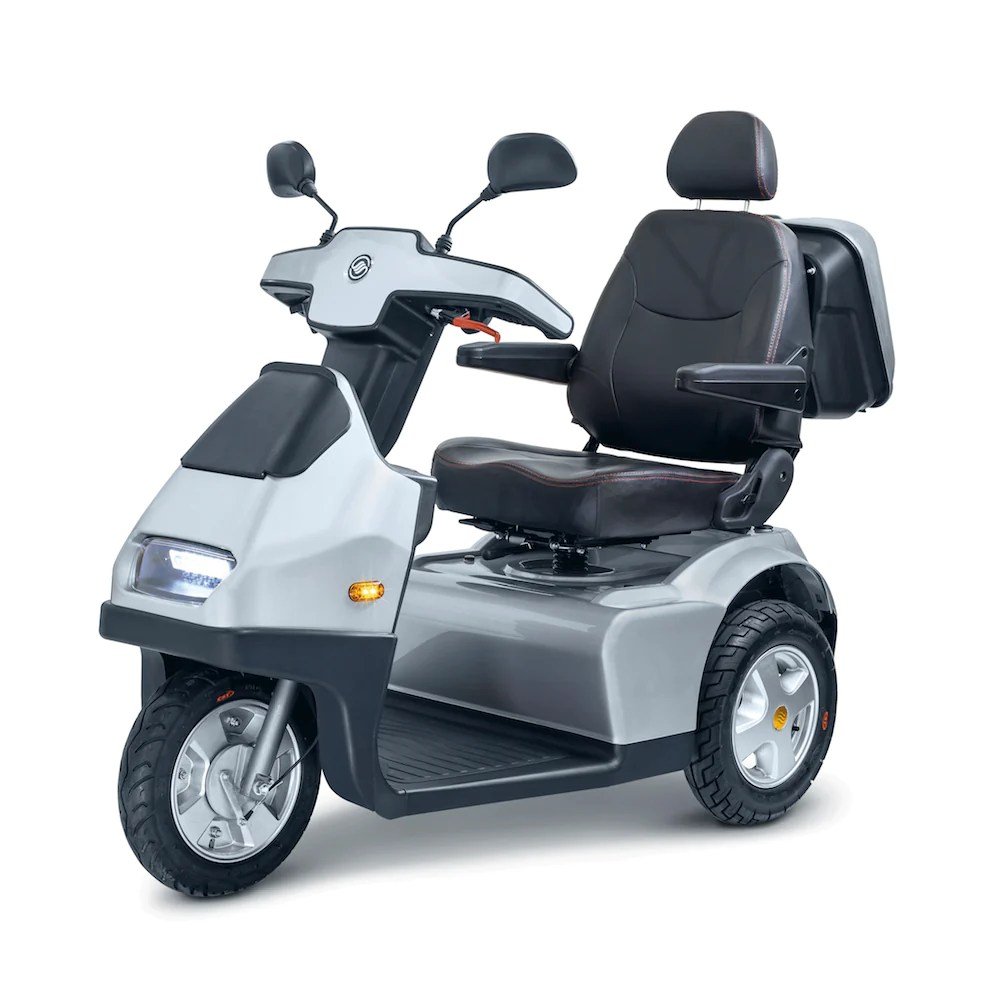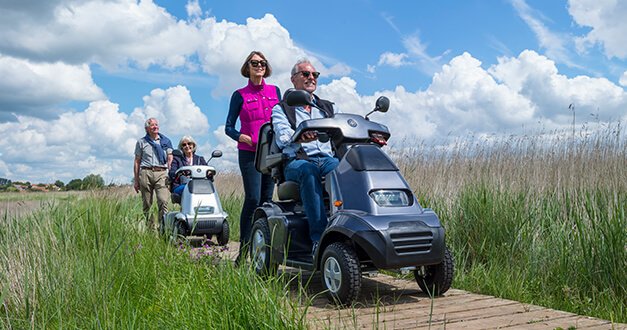In today’s fast-paced world, mobility is key. For those with limited mobility, whether due to age or disability, mobility scooters offer a lifeline to independence and freedom.
So, it is important to know what the best mobility scooters are.
Because the need for reliable mobility solutions grows as the population ages and accessibility becomes increasingly important.
Mobility scooters offer a practical solution for individuals who struggle with traditional modes of transportation.
In this article, we’ll explore the best mobility scooters in 2024, helping you make an informed decision and empowering you to find the perfect fit for your needs and budget.
What is a Mobility Scooter?
What are the Key Factors for Mobility Scooter Selection?
Whatever model you choose, these are the key factors guiding your search:
Terrain and Environment:
- Smooth surfaces: Opt for a standard scooter with smaller wheels for indoor use or in well-paved areas.
- Uneven terrain: Consider a heavy-duty scooter with larger wheels and better suspension for outdoor adventures.
- Tight spaces: Choose a compact scooter for navigating crowded stores or busy sidewalks
Mobility level:
- Limited walking: A basic scooter may suffice for short distances and indoor use.
- Moderate needs: A mid-range scooter offers more Comfort and stability for longer outings.
- Severe limitations: Consider a heavy-duty scooter with additional features like swivel seats or oxygen tanks.
Range and speed:
- Short trips: A standard scooter with a short range is sufficient for errands or local rides.
- Longer distances: Choose a scooter with a larger battery for longer journeys.
- Speed preference: Consider your comfort level and local regulations when choosing a scooter’s speed.
Needs and Lifestyle:
- Storage and portability:Opt for a foldable scooter if space is limited or you must transport it often.
- Comfort and features:Choose adjustable seats, armrests, and storage options that suit your needs.
- Budget:Set a realistic budget and prioritize the features that are most relevant to you.
What are the Types of Mobility Scooters: Pros Vs Cons
Pros:
- Compact.
- Maneuverable.
- Ideal for indoor use.
- Tight spaces.
Cons:
- Less stable than four-wheelers at higher speeds or on uneven terrain.
Pros:
- Increased stability.
- Better for outdoor use.
- Good for uneven surfaces.
Cons:
- Larger turning radius.
- less maneuverable in tight spaces.
Travel Mobility Scooters:
Pros:
- Lightweight.
- portable.
- Disassembled for easy vehicle transport.
Cons:
- Lower weight capacity.
- Shorter range.
- Less powerful motors.
Pros:
- High weight capacity.
- Powerful incline motors.
- Large seats.
Cons:
- Bulky.
- Less maneuverable.
- Higher price point.
Top 4 Best Mobility Scooters in 2024
Here are our top 4 picks and their uses.
1. Afiscooter S3 – Single Seat 3 Wheel Outdoor Mobility Scooter

Details & Specifications:
- Standard size: Length 155cm (61 inches), Width 68cm (27 inches) & Height 125cm (49 inches).
- Standard Weight: 153kg (337lb).
- Standard Weight Capacity: 200kg (450lb).
- Maximum Travel Range: 55-60km (36-38m).
The Best 3 Wheel Outdoor, Single Seat 51cm (20″) Heavy-Duty 3-Wheel Mobility Scooter has a very small 56-inch turning radius and a maximum speed of 10-15Kph (6.2-9.3mph).
SE single-seat scooter by Afikim has a maximum climbing angle of 8o (15%) to 11o (20%). This model’s powerhouse pack consists of 2 x Batteries of 12V 105Ah Max.
It is also equipped with a canopy with a height of 39cm (15 inches) to overcome all weather effects.
2. Afiscooter S3 – Wide Seat 3 Wheel Outdoor Mobility Scooter

Details & Specifications:
- Standard size: Length 155cm (61 inches), Width 96cm (37 inches) & Height 125cm (49 inches)
- Standard Weught: 163kg (359lb).
- Standard Weight Capacity: 200kg (450lb).
- Maximum Travel Range: 45-50km (28-31m).
The Best 3 Wheel Outdoor, Wide Seat 85cm (33″) Heavy-Duty, all-terrain Mobility Scooter has a very small 56-inch turning radius and a maximum speed of 10-15Kph (6.2-9.3mph).
With a maximum climbing angle of 8 Degrees (15%) to 11 Degrees (20%), a dual-seat scooter by Afikim can climb steeply.
The 3-wheel extra wide seat version uses 2 batteries of 12V 105Ah maximum. For varied weather conditions, you can add a canopy with a height of 39 cm (15 inches).
3. Afiscooter S4 – Single Seat 4 Wheel All Terrain Mobility Scooter

Details & Specifications:
- Standard size: Length 165cm (65 inches), Width 68cm (27 inches) & Height 125cm (49 inches)
- Standard Weight: 155kg (342lb).
- Standard Weight Capacity: 250kg (500lb).
- Maximum Travel Range: 55-60km (36-38m).
The Best 4-wheel outdoor mobility scooter with a single seat of 51cm (20″) with exceptional comfort for off-road.
Single seat S4 Mobility Scooter has a 228cm (90 inches) turning radius and a maximum speed of 10-15 kph (6.2-9.3mph).
With a maximum climbing angle of 8 Degrees (15%) to 11 Degrees (20%), a single-seat scooter by Afikim can climb slightly. The 4-wheel one seat version uses 2 batteries of 12V 105Ah maximum.
It features a front tyre size of 4.10/3.50-6 inches and a rear tyre of 3.50-10 inches, enhancing scooter stability, especially for elderly drivers.
4. Afiscooter S4 Wide – 4 Wheel All Terrain Mobility Scooter

Details & Specifications:
- Standard size: Length 165cm (65 inches), Width 96cm (37 inches) & Height 125cm (49 inches)
- Standard Weight: 165kg (364lb).
- Standard Weight Capacity: 250kg (500lb).
- Maximum Travel Range: 55-60km (36-38m).
The Best 4-wheel outdoor, heavy-duty mobility scooter with a wide seat of 85cm (33″) and exceptional comfort on and off-road.
Afiscooter S4 wide seat Mobility Scooter has a 228cm (90 inches) turning radius and a maximum speed of 10-15 kph (6.2-9.3mph).
With a maximum climbing angle of 8 Degrees (15%), 15 kph to 11 Degrees (20%) 12kp, a double-seat scooter by Afikim.
The 4-wheeled dual seat version uses 2 batteries of 12V 105Ah maximum. It features a front tyre size of 4.10/3.50-6 inches and a rear tyre of 3.50-10 inches, enhancing extra scooter stability, especially for adult drivers.
A Mobility Scooter's Top 6 Most Important Considerations.
- Controls: Intuitive joystick, tiller, or fingertip controls cater to different preferences and dexterity levels.
- Safety features: Look for reflectors, lights, and emergency brakes for safe operation.
- Physical dimensions: User height, weight, and hand dexterity influence seat size, weight capacity, and control options.
- Physical Attributes: Weight capacity, seat size, and adjustability are crucial. Ensure the scooter accommodates your height, weight, and physical limitations.
- Battery Life: Consider battery type (lead-acid or lithium-ion) for weight, charging time, and lifespan factors.
- Warranty and support: Consider warranty coverage and repair services availability.
Conclusion:
In conclusion, your best mobility scooter in 2024 depends on your needs, preferences, and budget. By considering factors such as type, weight capacity, battery life, terrain suitability, and portability, you can make an informed decision that enhances mobility and independence.
FAQs:
1. Are mobility scooters suitable for indoor use?
Yes, but with some caveats! It depends on:
• The size and layout of your home: Choose a scooter with a tight turning radius and good maneuverability for navigating tight spaces.
• Floor surfaces: Ensure your scooter can handle the type of flooring (carpet, tile, and hardwood) you have. Some models have specific features for different surfaces.
• Doorways and thresholds: Measure your doorways and consider scooters with adjustable ground clearance to overcome small obstacles.
2. Can I take my mobility scooter on public transportation?
It depends on the specific mode of transportation and its accessibility policies.
Some buses have designated areas for mobility scooters, while others might not have enough space. Trains and subways may have specific requirements or restrictions.
Always check with the transport provider beforehand.
3. What is the average mobility scooter battery lifespan?
The average lifespan ranges from 2 to 5 years, depending on:
• Battery type: Lithium-ion batteries last longer than lead-acid batteries.
• Usage and care: Proper charging habits and avoiding extreme temperatures extend battery life.
• Terrain: Frequent use on steep inclines or rough terrain can wear out batteries faster.
4. Do mobility scooters require regular maintenance?
Yes, regular maintenance is crucial for safety and longevity, which includes:
• Checking tire pressure and tread: Ensure proper inflation and replace worn tires promptly.
• Cleaning and inspecting the scooter: Look for signs of wear, damage, or loose connections.
• Following manufacturer’s maintenance instructions: Consult your manual for specific recommendations.
5. Are mobility scooters insured?
Yes, some insurance options cover mobility scooters, which include:
• Homeowner’s or renter’s insurance: May cover theft or damage to scooters within your home.
• Liability insurance: Protects you if you accidentally hurt or damage others while using your scooter.
• Collision insurance: Covers damage to your scooter in an accident.



